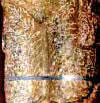|
by Mario Montano Aragón
Chapter 1 - Fuente Magna
Maximiliano and Cuneiform Fuente Magna We found the gathering, and Maximiliano was there. Delegate from UNAAR , "Unidad de Arqueologia y Antropologia de Bolivia", asked him for the fountain. He didn't remembered, so we decided to show him a picture of it with he cuneiform writings I have taken with me... he recognized it immediately and called it by the name: "El Plato del Chancho" (the pig's dish).
We almost fainted when the translator told us the history, it was an
exact copy of what was published about it. Also, he said that he would speak
better at his home, but he was at the meeting right now, that his brother
probably has another, that there were several, and even pottery was found at
the place, etc... and the bomb: "The fountain was found here" he said
pointing at a group of tacanas (staired monticules) in front of us. Again, we
could not believe our luck. Because it was the harvest time, the translator
warned us not go up there at this time, because if a rain or a blizzard
felt, we could be seen as the bad luck bringers and they will not allow us
to research there anymore.
Chapter 2 - Monolith of Pokotia
The Pokotia monolith was discovered by Bernardo Biados, Freddy Arce, Javier Escalente, Cesar Calisaya, Leocadio Ticlla, Alberto Vasquez, Alvaro Fernholz, Omar Sadud, Paulo Batuani and Rodrigo Velasco on January 4, 2002. This discovery and other research done by these scientist is supported by the Honorable H. Enrique Enrique Toro, President of the Congress of Bolivia.
Originally it was believed that there was an inscription written only on the front legs of the monolith, further research indicated that there was also an inscription on the back of the statue and directly below the left hand of the figure. Pictures below show inscriptions on the back and side of the Pokotia Monolith.
|





